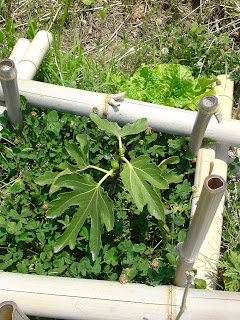We are currently in the midst of a 'stealthy drought'. It's been raining off and on, but the amounts have apparently been trivial. The first hint of drought was when Matsuyama City suddenly announced that groundwater was at 40% levels. Everything came up nice and green at the beginning of spring, but when we had a full week of sunny weather recently, the new growth suddenly started to turning brown. Or even black in some cases, where the new growth is especially new. Once again, the clover has all wilted and makes a crispy, crunchy sound underfoot. This seems all the stranger since my rainwater butt is still full.
There's quite a stark contrast between my vegetable plot and the garden areas around the house. In the vegetable plot, I buried a lot of compost from our old house, leaves, straw, rice husks -- charred and raw, and new compost. This organically-charged soil holds a great deal of moisture making the plants very resilient.
But look at the soil in that white bucket below from in the garden. It's just rock dust. When rain falls, the surface turns to mud while below the surface it remains a hard, dry, compacted mass.

I bought a metal tool with which I fondly imagined I could dig out deep 'cores' of soil. But after digging six or so small holes about 18 cm deep, the inside of my knuckles were beginning to get sore from gripping my new tool and banging it into the ground. (Panic! I type for my living!)

If you look at the far side of this hole, you can see streaks of white powder. This is where the tool has crushed some of the grains of quartz in the soil. The whole situation screams "Inabsorbent!"

Having made some biochar, the question arises, what to do with it. I hit on the idea of making
Terra Preta holes. Since it's impossible to deal at one stroke with the great expanse of dryness that currently presents itself, I resolved to make small areas that retain moisture and contain the ingredients of fertility.

This hole contains bits of biochar mixed with compost. The compost contains a lot of rice husks, weeds, and kitchen waste, including seashells.
If I make enough of these holes, they should eventually join up into a single layer ('
horizon' as we scientists call them), and the garden should be able to withstand drought better.

Well, even if my soil is rather horrible at the moment, it is located in a good spot, generally speaking.
 Queries answered include;
Queries answered include;

















